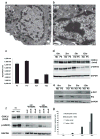A syndrome with congenital neutropenia and mutations in G6PC3
- PMID: 19118303
- PMCID: PMC2778311
- DOI: 10.1056/NEJMoa0805051
A syndrome with congenital neutropenia and mutations in G6PC3
Erratum in
- N Engl J Med. 2011 Apr 28;364(17):1682
Abstract
Background: The main features of severe congenital neutropenia are the onset of severe bacterial infections early in life, a paucity of mature neutrophils, and an increased risk of leukemia. In many patients, the genetic causes of severe congenital neutropenia are unknown.
Methods: We performed genomewide genotyping and linkage analysis on two consanguineous pedigrees with a total of five children affected with severe congenital neutropenia. Candidate genes from the linkage interval were sequenced. Functional assays and reconstitution experiments were carried out.
Results: All index patients were susceptible to bacterial infections and had very few mature neutrophils in the bone marrow; structural heart defects, urogenital abnormalities, and venous angiectasia on the trunk and extremities were additional features. Linkage analysis of the two index families yielded a combined multipoint lod score of 5.74 on a linkage interval on chromosome 17q21. Sequencing of G6PC3, the candidate gene encoding glucose-6-phosphatase, catalytic subunit 3, revealed a homozygous missense mutation in exon 6 that abolished the enzymatic activity of glucose-6-phosphatase in all affected children in the two families. The patients' neutrophils and fibroblasts had increased susceptibility to apoptosis. The myeloid cells showed evidence of increased endoplasmic reticulum stress and increased activity of glycogen synthase kinase 3beta (GSK-3beta). We identified seven additional, unrelated patients who had severe congenital neutropenia with syndromic features and distinct biallelic mutations in G6PC3.
Conclusions: Defective function of glucose-6-phosphatase, catalytic subunit 3, underlies a severe congenital neutropenia syndrome associated with cardiac and urogenital malformations.
2009 Massachusetts Medical Society
Figures




Comment in
-
The many causes of severe congenital neutropenia.N Engl J Med. 2009 Jan 1;360(1):3-5. doi: 10.1056/NEJMp0806821. N Engl J Med. 2009. PMID: 19118300 Free PMC article. No abstract available.
References
-
- Welte K, Zeidler C, Dale DC. Severe congenital neutropenia. Semin Hematol. 2006;43:189–95. - PubMed
-
- Boztug K, Welte K, Zeidler C, Klein C. Congenital Neutropenia Syndromes. Immunol Allergy Clin North Am. 2008;28:259–75. - PubMed
-
- Kostmann R. Hereditär reticulos––en ny systemsjukdom. Svenska Läkartidningen. 1950;47:2861.
-
- Kostmann R. Infantile genetic agranulocytosis; agranulocytosis infantilis hereditaria. Acta Paediatr. 1956;45 (Suppl 105):1–78. - PubMed
-
- Bonilla MA, Gillio AP, Ruggeiro M, et al. Effects of recombinant human granulocyte colony-stimulating factor on neutropenia in patients with congenital agranulocytosis. N Engl J Med. 1989;320:1574–80. - PubMed
Publication types
MeSH terms
Substances
Grants and funding
LinkOut - more resources
Full Text Sources
Other Literature Sources
Medical
Molecular Biology Databases
